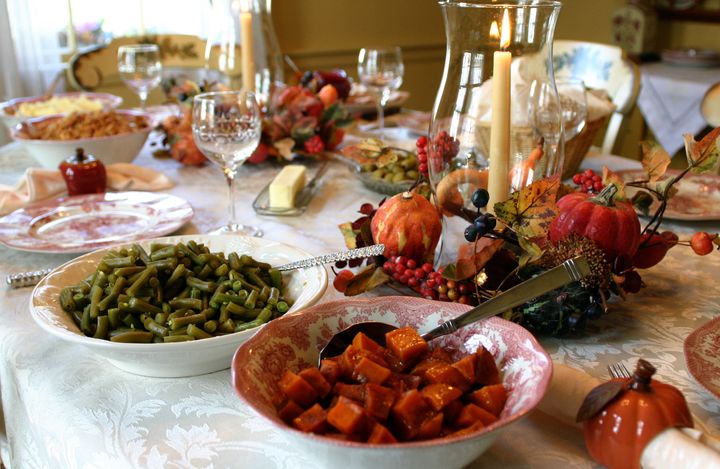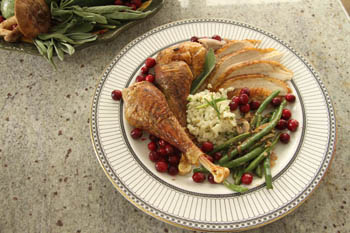
 Aside from its historical significance, most of us associate Turkey Day with a huge dinner centered on the bird responsible for its moniker. Thanksgiving and food go hand and hand, rooted in the tradition of celebrating a successful harvest and the fruits that follow. By contemporary interpretations, many of us are thankful for more than just the colorful potpourri of food on our plate. How do we show our appreciation? Some thanks are easier to articulate than others. As a physician, I find myself thinking about the ways in which we can thank our bodies. This demonstration of gratitude doesn't usually manifest itself verbally, but rather through our actions and lifestyles. Eating and thanks are intertwined; and maintaining a healthy diet is a direct way to thank the body and the organs, especially the kidneys, for the work they do each and every day to keep us functioning at our best.
Aside from its historical significance, most of us associate Turkey Day with a huge dinner centered on the bird responsible for its moniker. Thanksgiving and food go hand and hand, rooted in the tradition of celebrating a successful harvest and the fruits that follow. By contemporary interpretations, many of us are thankful for more than just the colorful potpourri of food on our plate. How do we show our appreciation? Some thanks are easier to articulate than others. As a physician, I find myself thinking about the ways in which we can thank our bodies. This demonstration of gratitude doesn't usually manifest itself verbally, but rather through our actions and lifestyles. Eating and thanks are intertwined; and maintaining a healthy diet is a direct way to thank the body and the organs, especially the kidneys, for the work they do each and every day to keep us functioning at our best.
With the holiday around the corner, seasoned and aspiring cooks in households across America plan to fill their tables with a cornucopia of comfort foods. Before you run to the grocery store, I challenge you to evaluate what you put in your body by way of your holiday table. Most of us know that butter-laden dishes aren't healthy, but were you aware that traditionally prepared Thanksgiving recipes are often also exceedingly high in salt?
Sodium chloride (salt) fulfills a vital role in the body, but generally speaking most of us consume too much of it. A high-salt diet can lead to high blood pressure, a leading cause of kidney disease. It's recommended that healthy adults consume a daily maximum of about 2,400 milligrams of sodium, which is about a teaspoon of salt. The recommendation is even less for those who have other health conditions such as high blood pressure or kidney disease.
To put it in perspective, imagine a traditional Thanksgiving meal comprised of turkey, gravy, stuffing, mashed potatoes and pumpkin pie. Even when exhibiting portion control -- which most of us can admit isn't at our best while dining at the Thanksgiving table -- by some estimates, this meal contains about 1,800 mg of sodium. That's already 75 percent the daily recommendation before any appetizers, alcohol or second helpings (not to mention breakfast, lunch, or anything else that passes your lips throughout the day). Now that it's clear we're gobbling down too much salt, there's plenty that we can do to cut back.
Where do you start? Salt can be pretty sneaky. It may have an obvious presence in the shaker, but it's a master at hiding in other places. Even in plain sight on the nutrition label. That's because often the focus is on the calories, fat or sugar content in the foods we eat. It's time to wake up, smell the gravy and start paying attention to the places sodium lurks. Restaurants are a main offender. Processed foods -- including frozen dinners and canned items -- represent another culprit. Even sweets and desserts contain salt, despite not tasting "salty." Eating fresh fruits, vegetables, and non-brined meats and choosing sodium-free and low-sodium products are just a few of the ways we can reduce our salt intake. (For additional specifics on following a low-sodium lifestyle, check out the DASH diet.)
When it comes to your Thanksgiving table, you can lose the salt without sacrificing the flavor or the mouthwatering aromas that accompany cooking. To help pave the way, the National Kidney Foundation has partnered with Jessica Goldman Foung, also known as "Sodium Girl", to create some new low-sodium twists on your old favorite recipes. The spotlight's on the bird this season, so let it shine by watching Sodium Girl share her quick tips on how to prepare the perfect low-sodium turkey. Make sure you check out her kidney-friendly recipe for Cranberry Ginger Apricot Chutney for a new take on the traditional dish.
Your Thanksgiving meal will taste as good as it looks this year and you might even be less likely to experience post-holiday eater's remorse. Okay, no promises there, but thank your body and your body will be the one thanking you in the end.
How do you thank your body? Please share in the comments below.
For more information about high blood pressure, your kidneys and kidney disease, visit www.kidney.org.
For more by Leslie Spry, M.D., FACP, click here.
For more on diet and nutrition, click here.
For more on Thanksgiving, click here.